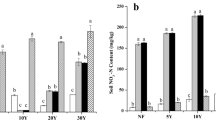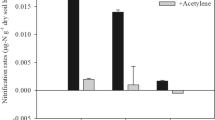Abstract
Purpose
Nitrification, the microbial oxidation of ammonia to nitrate via nitrite, is a pivotal component of the biogeochemical nitrogen cycle. Nitrification was conventionally assumed as a two-step process in which ammonia oxidation was thought to be catalyzed by ammonia-oxidizing archaea (AOA) and bacteria (AOB), as well as nitrite oxidation by nitrite-oxidizing bacteria (NOB). This long-held assumption of labour division between the two functional groups, however, was challenged by the recent unexpected discovery of complete ammonia oxidizers within the Nitrospira genus that are capable of converting ammonia to nitrate in a single organism (comammox). This breakthrough raised fundamental questions on the niche specialization and differentiation of comammox organisms with other canonical nitrifying prokaryotes in terrestrial ecosystems.
Materials and methods
This article provides an overview of the recent insights into the genomic analysis, physiological characterization and environmental investigation of the comammox organisms, which have dramatically changed our perspective on the aerobic nitrification process. By using quantitative PCR analysis, we also compared the abundances of comammox Nitrospira clade A and clade B, AOA, AOB and NOB in 300 forest soil samples from China spanning a wide range of soil pH.
Results and discussion
Comammox Nitrospira are environmentally widespread and numerically abundant in natural and engineered habitats. Physiological data, including ammonia oxidation kinetics and metabolic versatility, and comparative genomic analysis revealed that comammox organisms might functionally outcompete other canonical nitrifiers under highly oligotrophic conditions. These findings highlight the necessity in future studies to re-evaluate the niche differentiation between ammonia oxidizers and their relative contribution to nitrification in various terrestrial ecosystems by including comammox Nitrospira in such comparisons.
Conclusions
The discovery of comammox and their broad environmental distribution added a new dimension to our knowledge of the biochemistry and physiology of nitrification and has far-reaching implications for refined strategies to manipulate nitrification in terrestrial ecosystems and to maximize agricultural productivity and sustainability.



Similar content being viewed by others
References
Alonso-Sáez L, Waller AS, Mende DR, Bakker K, Farnelid H, Yager PL et al (2012) Role for urea in nitrification by polar marine Archaea. Proc Natl Acad Sci U S A 109:17989–17994
Arp D, Bottomley PJ (2006) Nitrifier: more than 100 years from isolation to genome sequences. Microbe 1:229–234
Bartelme RP, McLellan SL, Newton RJ (2017) Freshwater recirculating aquaculture system operations drive biofilter bacterial community shifts around a stable nitrifying consortium of ammonia-oxidizing archaea and comammox Nitrospira. Front Microbiol 8:101
Burton SAQ, Prosser JI (2001) Autotrophic ammonia oxidation at low pH through urea hydrolysis. Appl Environ Microbiol 67:2952–2957
Camejo PY, Domingo JS, McMahon KD, Moguera DR (2017) Genome-enabled insights into the ecophysiology of the comammox bacterium Candidatus Nitrospira nitrosa. mSystems. https://doi.org/10.1128/mSystems.00059-17
Chao Y, Mao Y, Yu K, Zhang T (2016) Novel nitrifiers and comammox in a full-scale hybrid biofilm and activated sludge reactor revealed by metagenomics approach. Appl Microbiol Biotechnol 100:8225–8237
Costa E, Perez J, Kreft JU (2006) Why is metabolic labour divided in nitrification? Trends Microbiol 14:213–219
Daims H, Lebedeva EV, Pjevac P, Han P, Herbold C, Albertsen M et al (2015) Complete nitrification by Nitrospira bacteria. Nature 528:504–509
Daims H, Lucker S, Wagner M (2016) A new perspective on microbes formerly known as nitrite-oxidizing bacteria. Trends Microbiol 24:699–712
Foesel BU, Gieseke A, Schwerner C, Stief P, Koch L, Cytryn E et al (2008) Nitrosomonas Nm143-like ammonia oxidizers and Nitrospira marina-like nitrite oxidizers dominate the nitrifier community in a marine aquaculture biofilm. FEMS Microbiol Ecol 63:192–204
Gao JF, Fan XY, Pan KL, Li HY, Sun LX (2016) Diversity, abundance and activity of ammonia-oxidizing microorganisms in fine particulate matter. Sci Rep 6:38785
Gonzalez-Martinez A, Rodriguez-Sanchez A, van Loosdrecht MCM, Gonzalez-Lopez J, Vahala R (2016) Detection of comammox bacteria in full-scale wastewater treatment bioreactors using tag-454-pyrosequencing. Environ Sci Pollut Res 23:25501–25511
Gruber-Dorninger C, Pester M, Kitzinger K, Savio DF, Loy A, Rattei T, Wagner M, Damis H (2015) Functionally relevant diversity of closely related Nitrospira in activated sludge. ISME J 9:643–655
He JZ, Shen JP, Zhang LM, Zhu YG, Zheng YM, Xu MG, Di H (2007) Quantitative analyses of the abundance and composition of ammonia-oxidizing bacteria and ammonia-oxidizing archaea of a Chinese upland red soil under long-term fertilization practices. Environ Microbiol 9:2364–2374
He JZ, Hu HW, Zhang LM (2012) Current insights into the autotrophic thaumarchaeal ammonia oxidation in acidic soils. Soil Biol Biochem 55:146–154
Hink L, Nicol GW, Prosser JI (2016) Archaea produce lower yields of N2O than bacteria during aerobic ammonia oxidation in soil. Environ Microbiol. https://doi.org/10.1111/1462-2920.13282
Hu HW, Zhang LM, Dai Y, Di HJ, He JZ (2013) pH-dependent distribution of soil ammonia oxidizers across a large geographical scale as revealed by high-throughput pyrosequencing. J Soils Sediments 13:1439–1449
Hu HW, Xu ZH, He JZ (2014) Ammonia-oxidizing archaea play a predominant role in acid soil nitrification. Adv Agron 125:261–302
Hu HW, Chen D, He JZ (2015a) Microbial regulation of terrestrial nitrous oxide formation: understanding the biological pathways for prediction of emission rates. FEMS Microbiol Rev 39:729–749
Hu HW, Macdonald CA, Trivedi P, Holmes B, Bodrossy L, He JZ, Singh BK (2015b) Water addition regulates the metabolic activity of ammonia oxidizers responding to environmental perturbations in dry subhumid ecosystems. Environ Microbiol 17:444–461
Hu HW, Trivedi P, He JZ, Singh BK (2017) Microbial nitrous oxide emissions in dryland ecosystems: mechanisms, microbiome and mitigation. Environ Microbiol. https://doi.org/10.1111/1462-2920.13795
Jung MY, Park SJ, Min D, Kim JS, Rijpstra WIC, Dameste JSS, Kim GJ, Madsen EL, Rhee SK (2011) Enrichment and characterization of an autotrophic ammonia-oxidizing archaeon of mesophilic crenarchaeal group I.1a from an agricultural soil. Appl Environ Microbiol 77:8635–8647
Ke X, Angel R, Lu Y, Conrad R (2013) Niche differentiation of ammonia oxidizers and nitrite oxidizers in rice paddy soil. Environ Microbiol 15:2275–2292
Kits KD, Sedlacek CJ, Lebedeva EV, Han P, Bulaev A, Pjevac P et al (2017) Kinetic analysis of a complete nitrifier reveals an oligotrophic lifestyle. Nature. https://doi.org/10.1038/nature23679
Koch H, Lucker S, Albertsen M, Kitzinger K, Herbold C, Spieck E et al (2015) Expanded metabolic versatility of ubiquitous nitrite-oxidizing bacteria from the genus Nitrospira. Proc Nat Acad Sci USA 112:11371–11376
Könneke M, Bernhard AE, Jose R, Walker CB, Waterbury JB, Stahl DA (2005) Isolation of an autotrophic ammonia-oxidizing marine archaeon. Nature 437:543–546
Kuypers MMM (2015) Microbiology: a division of labour combined. Nature 528:487–488
Lebedeva EV, Hatzenpichler R, Pelletier E, Schuster N, Hauzmayer S, Bulaev A et al (2013) Enrichment and genome sequence of the group I.1a ammonia-oxidizing archaeon “Ca. Nitrosotenuis uzonensis” representing a clade globally distributed in thermal habitats. PLoS One 8:e80835
Lehtovirta-Morley LE, Stoecker K, Vilcinskas A, Prosser JI, Nicol GW (2011) Cultivation of an obligate acidophilic ammonia oxidizer from a nitrifying acid soil. Proc Natl Acad Sci U S A 108:15892–15897
Leininger S, Urich T, Schloter M, Schwark L, Qi J, Nicol G, Prosser JI, Schuster SC, Schleper C (2006) Archaea predominate among ammonia-oxidizing prokaryotes in soils. Nature 442:806–809
Lu L, Jia Z (2013) Urea gene-containing archaea dominate autotrophic ammonia oxidation in two acid soils. Environ Microbiol 15:1795–1809
Martens-Habbena W, Berube PM, Urakawa H, de la Torre JR, Stahl DA (2009) Ammonia oxidation kinetics determine niche separation of nitrifying Archaea and bacteria. Nature 461:976–979
Nicol GW, Leininger S, Schleper C, Prosser JI (2008) The influence of soil pH on the diversity, abundance and transcriptional activity of ammonia oxidizing archaea and bacteria. Environ Microbiol 10:2966–2978
Nunes-Alves C (2016) Do it yourself nitrification. Nat Rev Microbiol 14:61
Palatinszky M, Herbold C, Jehmlich N, Pogoda M, Han P, von Bergen M et al (2015) Cyanate as an energy source for nitrifiers. Nature 524:105–108
Palomo A, Fowler SJ, Gulay A, Rasmussen S, Sicheritz-Ponten T, Smets BF (2016) Metagenomic analysis of rapid gravity sand filter microbial communities suggests novel physiology of Nitrospira spp. ISME J 10:2569–2580
Palomo A, Pedersen AG, Fowler SJ, Dechesne A, Sicheritz-Ponten T, Smets BF (2017) Comparative genomics sheds light on niche differentiation and the evolutionary history of comammox Nitrospira. bioRxiv. https://doi.org/10.1101/138586
Park BJ, Park SJ, Yoon DN, Schouten S, Damste JSS, Rhee SK (2010) Cultivation of autotrophic ammonia-oxidizing archaea from marine sediments in coculture with sulfur-oxidizing bacteria. Appl Environ Microbiol 76:7575–7587
Pester M, Maixner F, Berry D, Rattei T, Koch H, Lucker S et al (2014) NxrB encoding the beta subunit of nitrite oxidoreductase as functional and phylogenetic marker for nitrite-oxidizing Nitrospira. Environ Microbiol 16:3055–3071
Pinto AJ, Marcus DN, Ijaz UZ, Bautista-de lose Santos QM, Dick GJ, Raskin L (2015) Metagenomic evidence for the presence of comammox Nitrospira-like bacteria in a drinking water system. mSphere 1:e00054–e00015
Pjevac P, Schauberger C, Poghosyan L, Herbold CW, van Kessel MAHJ, Daebeler A et al (2017) AmoA-targeted polymerase chain reaction primers for the specific detection and quantification of comammox Nitrospira in the environment. Front Microbiol 8:1508
Prosser JI (2011) Soil nitrifiers and nitrification. In: Ward BB, Arp DJ, Klotz MG (eds) Nitrification. ASM Press, Washington, DC, pp 347–383
Prosser JI, Nicol GW (2012) Archaeal and bacterial ammonia-oxidizers in soil: the quest for niche specialisation and differentiation. Trends Microbiol 20:523–531
Santoro AE (2016) The do-it-all nitrifier. Science 351:342–343
Shi XZ, Hu HW, Kelly K, Chen D, He JZ, Suter HC (2016a) Responses of ammonia oxidizers and denitrifiers to repeated applications of a nitrification inhibitor and a urease inhibitor in two pasture soils. J Soils Sediments 17:974–984
Shi XZ, Hu HW, Müller C, He JZ, Chen D, Suter HC (2016b) Effects of the nitrification inhibitor 3,4-dimethylpyrazole phosphate on nitrification and nitrifiers in two contrasting agricultural soils. Appl Environ Microbiol 82:5236–5248
Shi XZ, Hu HW, Zhu-Barker X, Hayden H, Wang JT, Suter H, Chen D, He JZ (2017) Nitrifier-induced denitrification is an important source of soil nitrous oxide and can be inhibited by a nitrification inhibitor 3,4-dimethylpyrazole phosphate. Environ Microbiol. https://doi.org/10.1111/1462-2920.13872
Spang A, Poehlein A, Offre P, Zumbrägel S, Haider S, Rychlik N et al (2012) The genome of the ammonia-oxidizing Candidatus Nitrososphaera gargensis: insights into metabolic versatility and environmental adaptations. Environ Microbiol 14:3122–3145
Stieglmeier M, Mooshammer M, Kitzler B, Wanek W, Zechmeister-Boltenstem S, Richter A et al (2014) Aerobic nitrous oxide production through N-nitrosating hybrid formation in ammonia-oxidizing archaea. ISME J 8:1135–1146
Stoecker K, Bendinger B, Schoning B, Nielsen PH, Nielsen JL, Baranyi C et al (2006) Cohn’s Crenothrix is a filamentous methane oxidizer with an unusual methane monooxygenase. Proc Natl Acad Sci U S A 103:2363–2367
Tourna M, Stieglmeier M, Spang A, Könneke M, Schintlmeister A, Urich T et al (2011) Nitrososphaera viennensis, an ammonia oxidizing archaeon from soil. Proc Natl Acad Sci U S A 108:8420–8425
van Kessel MA, Speth DR, Albertsen M, Nielsen PH, den Camp HJO, Kartal B et al (2015) Complete nitrification by a single microorganism. Nature 528:555–559
Wang BZ, Zhao J, Guo Z, Ma J, Xu H, Jia Z (2015) Differential contributions of ammonia oxidizers and nitrite oxidizers to nitrification in four paddy soils. ISME J 9:1062–1075
Wang JT, Zheng YM, Hu HW, Li J, Zhang LM, Chen BD, Chen WP, He JZ (2016) Coupling of soil prokaryotic diversity and plant diversity across latitudinal forest ecosystems. Sci Rep 6:19561
Wang Y, Ma L, Mao Y, Jiang X, Xia Y, Yu K, Li B, Zhang T (2017) Comammox in drinking water systems. Water Res 116:332–341
Wrighton KC, Thomas BC, Sharon I, Miller CS, Castelle CJ, VerBerkmoes NC et al (2012) Fermentation, hydrogen, and sulfur metabolism in multiple uncultivated bacterial phyla. Science 337:1661–1665
Zhang LM, Hu HW, Shen JP, He JZ (2012) Ammonia-oxidizing archaea have more important role than ammonia-oxidizing bacteria in ammonia oxidation of strongly acidic soils. ISME J 6:1032–1045
Funding
This work was financially supported by Natural Science Foundation of China (41230857) and the Australian Research Council (DE150100870; DP160101028).
Author information
Authors and Affiliations
Corresponding author
Additional information
Responsible editor: Zhihong Xu
Rights and permissions
About this article
Cite this article
Hu, HW., He, JZ. Comammox—a newly discovered nitrification process in the terrestrial nitrogen cycle. J Soils Sediments 17, 2709–2717 (2017). https://doi.org/10.1007/s11368-017-1851-9
Received:
Accepted:
Published:
Issue Date:
DOI: https://doi.org/10.1007/s11368-017-1851-9




